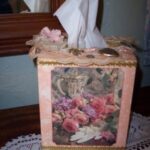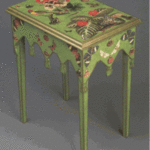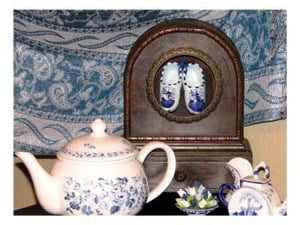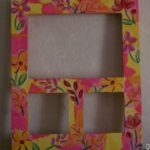With traditional decoupage, paper motifs are glued to an object and varnished until they appear to be part of the surface. It is not a difficult craft and one that, with a little patience, can be extremely rewarding.
Decoupage is one of the most satisfying ways to add character to plain accessories. A major attraction is that the basic technique is to straightforward, requiring little in the way of specialist or costly equipment.
Arm yourself with a pair of sharp scissors, printed paper, adhesive and varnish, find an object to decorate – and you are ready to start there and then.
For your first project it is best to decorate something small with a flat surface – an inexpensive trinket box is ideal. Rummage around at home, or look in charity or secondhand shops for a suitable item. Its condition doesn’t matter as it can be painted and the decoupage itself hides any imperfections.
If you buy a new item, plain objects made in wood or MDF (medium density fiber board) are inexpensive and perfectly suitable.
The real skill in decoupage lies in selecting paper motifs that flatter and are in keeping with the character and shape of the object being decorated. When you are decorating a new item, choose paint (if you are using it) and papers in colors and themes to coordinate with other furnishings in the room where it will be displayed. With older items choose motifs that are sympathetic to the period and style of the piece itself.
The decoration can be quite minimal. A single motif strategically place can be very effective, or it can be more involved, with a number of motifs grouped so that some of the background shows through. Alternatively, the entire surface can be covered with a collage of motifs, so that none of the background is visible, an option worth considering if the object is damaged.
For your first project, choose a small wooden item with a smooth, flat surface such as a box or tray. The wood should be bare. Remove any existing varnish at the start and fill all the cracks with a fine surface filler. Rub down any rough edges or surfaces with fine sandpaper, brush the resulting dust away and wipe the surface down with a damp cloth to clean it, making it easier to work with.
If the wood has an attractive grain, you may decide to stick the motifs straight on to the surface. Or, you can stain or paint it in a color which looks good with your chose motifs. Use emulsion or acrylic paint or a water-based stain.
Choosing papers:
The Victorians used specially printed motifs of flowers and fruit, butterflies and cherubs call decals for their decoupage decorations. You can buy similar images in sheet form from bookshops, art and craft shops and larger hardware stores.
Gift-wrapping paper is another good source of decoupage motifs. Most papers with a matt finish work well, provided they are printed on one side only, as any print on the underside tends to show through after gluing. Avoid foil wrapping paper, since it is difficult to lay flat without creasing.
You could also experiment with wallpapers, magazines, labels, tickets, stamps or photocopied pictures from books as alternative sources of motifs. If you want to use photocopies or paint your own motifs, you need to seal them first with a diluted PVA solution.
Mix one measure of glue into two equal measure of water and brush this over the surface of the motif. Allow it to dry before gluing to the object.
Look out for designs which have a variety of clearly identifiable shapes in a range of shades or colors. Motifs from different papers can be combined in one design as long as the papers are of a similar thickness.
Sealing the design:
Once you have stuck on the motifs and left them to dry, varnish the surface to protect it and give a smooth finish. Use a matt or satin water-based varnish. Several coats of matt varnish have a subtle sheen whereas two or three coats of satin varnish look quite shiny.
Decorating a small box:
The trinket box being used for this project is made of MDF. Before painting or applying decoupage motifs to bare MDF, you need to seal the surface with a coat of diluted PVA or undercoat to hold down any stray fibers. Once the sealant has dried, paint it to coordinate with the motifs. Water-based matt emulsion or acrylic paint is ideal.
After sticking on the motifs, varnish as for wood.
For this project you will need:
- Gift-wrap or other sort of paper with your choice of motifs
- Large sharp scissors
- Small sharp scissors
- Paper and pencil
- PVA adhesive
- Two small paint brushes
- Kitchen paper towel or sponge
- Wallpaper seam roller (optional)
- Clear water-based varnish in a matt or satin finish
- Wet and dry sand paper
- Neutral furniture wax
1. Cutting out the motifs: Using the large scissors roughly cut out motifs from the gift-wrap. With the smaller scissors trim the motifs precisely to get a smooth, even outline. Hold the small scissors at a slight inward angle to bevel the edge so that the motif lies flat on the surface when stuck down.
2. Working out the design: Draw round the lid on a piece of plain paper and lay out the motifs within the outline. Try overlapping some of the shapes and leaving a little plain background showing between others.
3. Sticking down the first motif: If the PVA is very thick, dilute it to the consistency of thin cream. Using a small, clean paint brush, carefully brush the PVA solution over the back of the first motif and position it on the box lid. Press it down firmly with a sheet of kitchen towel or a sponge, making sure that there are no bubbles under the motif. If you have a wallpaper seam roller, roll it gently over the edges.
4. Completing the design: Following your design plan, apply more motifs in the same way until you have covered the lid and decorated the sides of the box. Ensure that the finished surface is completely flat and even. Leave it to dry overnight.
5. Varnishing over the motifs: Apply a thin coat of varnish over the decoupaged surface with a soft brush. Allow the varnish to dry, and then sand lightly using fine wet and dry paper. Repeat twice to apply a total of three coats. For a smoother finish apply more coats of varnish and let dry.
6. Adding finishing touches: For a rich finish, apply a coat of neutral furniture wax over the surface of your decoupaged object. Buff to a deep shine.
7. A tip for covering the base: To neaten the base of your box or tray, cut a piece of colored felt to fit and glue it one.
Decoupage works well on rounded surfaces as well as flat one. You can also try it on different surface materials such as metals or ceramics. Flowerpots, candlesticks and picture frames with smooth, curved sides are particularly appropriate for decorating with motifs.
Prime metal surfaces with quick-drying metal primer before painting with a solvent-based undercoat and two coats of solvent-based satin sheen paint.
Before painting, terracotta needs to be sealed with a proprietary water sealer. You don’t need any special preparation for china – just brush on acrylic, emulsion or ceramic paint, or decoupage straight on to the surface.
For metal and ceramic surfaces, use PVA adhesive to stick on the motifs, following the steps as before. On metal and over solvent-based paints, use polyurethane varnish, which you must leave to dry overnight. Plastic items or those with highly sealed finishes are unsuitable for decoupage as the paint and adhesive do not stick well.






